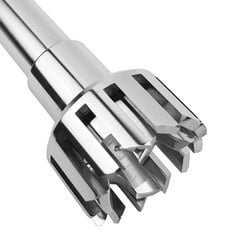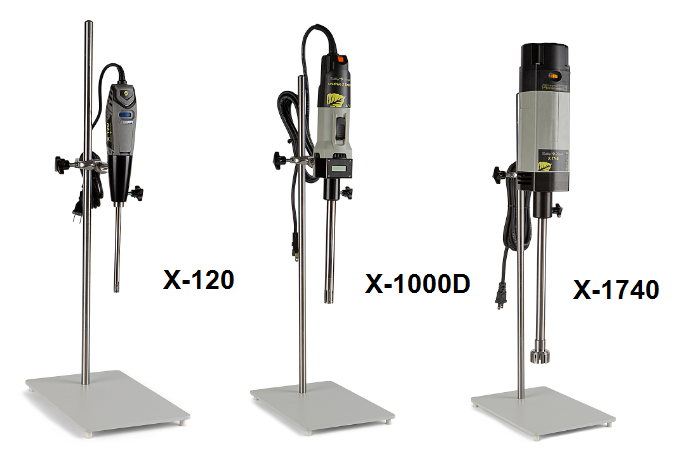You have no items in your shopping cart
Rotor Stator Homogenizers - Guide to Industrial and Laboratory Homogenizers
- Posted on
- Posted in Buyers Guides, Homogenizer, How To Guides
- 0

Rotor stator homogenizers
Laboratory Homogenizers are a wide variety of different units. This article will focus on High Shear Rotor Stator Homogenizers. These types of homogenizers utilize a high rpm, spinning rotor and a sheath or "stator" to emulsify samples using mechanical tearing.
What is a Rotor Stator Homogenizer?
Scientific high shear homogenizers comes in two parts, the motor and the shaft.
A motor is the large piece of equipment that controls the rpm's that the shaft operates at, either held by hand or mounted to a stand. Classifications for homogenizers start with their motor type. Such as Goldleafs X120, X1000D, and X1740 Homogenizers. The type of motor will decide if you are doing small scale emulsions for pharmaceutical mixing like blood and tissue samples, or large scale volumes for an industrial process such as food production.
X120 - About 250mls of thick oil at a time
X1000D - About 500mls of thick oil at a time
X1740 - About 1,000mls of thick oil at a time
These are the batch sizes of benchtop homogenizers only, larger flow through homogenizers can be used as well, call us if you need larger batch sizes.
The shaft is the next piece, the metal tube placed into your solution and actually performs the emulsion. Each shaft is meant for a different viscosity and volumes. The V shaft is best for viscous, thick oils. While the N shaft is for neutral, light weight samples like a liquid emulsion. The length and size of the shaft will determine the amount of raw materials the unit can work with at a time.
What is needed to operate a rotor stator homogenizer?
Homogenizer parts are very specific and cannot be interchanged. Each brand shaft should only go with the corresponding driver, they cannot be swapped between different brands or even different motors from the same brand.
There should be a vessel to hold your solution, a heavy duty lab stand that can handle the rpms of the homogenizer, and heavy duty clamps to hold everything in place. Depending on the type of emulsion you plan to do, a hot plate may be required to heat up your solution for ideal emulsification. Otherwise, a viscous shaft will not properly disperse the molecules throughout you mixture.
Each homogenizer will need a few parts to operate properly. These include:
-Universal rotor wrench : For cleaning and maintaining the shaft
-Universal socket wrench : For installing and removing the shaft
-Pedestal Stand : To mount the homogenizer
-Heavy Duty Clamp : To securely hold the unit while it vibrates
Spare parts are only needed when something breaks down, with proper cleaning and maintenance these units should not need any replacement parts for a long time. In case you notice the unit not working properly, Goldleaf can perform repairs and supply replacement parts when needed. These parts may include small pieces like o-rings and springs.
Do you need a rotor stator homogenizer?
If you need to create a consistent solution that has all of its molecules evenly dispersed, a rotor stator homogenizer is absolutely required. Especially needed when combining things like oil and water that do not mix easily. A lab homogenizer can come in many sizes, from hand held, to a benchtop homogenizer, to large scale flow through homogenizer skids. Also known as a high shear homogenizer, these units have wide applications in scientific and pharmaceutical uses.
How to use rotor stator homogenizers
These parameters apply to rotor stator homogenizers in general, whether for industrial, pilot plant laboratory, or pharmaceutical purposes. Assembly of the rotor stator homogenizers is very straightforward, the shafts come already built and are easy to connect to the driver. Details of these units can be found in their instruction manuals, along with specifications and special features. All units should have a dial or some form of control to precisely dial in the rpm's of the rotor.
Once the unit is assembled, heat up your solution if needed and prepare to mix. Place the end of the homogenizer into the vessel, there must be enough solution to cover the rotor and stator otherwise there will be insufficient dispersal. Turn the unit on at a low rpm to begin the process. The solution will be drawn into the shaft and submerge the rotor, the inert solution will be sheared and a visual change should occur.
Avoid creating a vortex in your solution, try to keep the vessel at an angle if possible. A high speed homogenizer can fully emulsify its solution in under a minute. Slowly ramp up the rpms as everything is beginning to mix.
Recommended rotor stator homogenizers from Goldleaf
Larger scale units perform 1-2 liter batches. Goldleafs X 1740 High Shear Rotor Stator Homogenizer is perfect for applications this size, a benchtop homogenizer at its largest scale. For a more industrial size, we offer a DK40 attachment that will allow for a connection to a large drum. Rotor stator homogenizers can handle large scale applications along with smaller batches down to 500ml, there is always a minimum amount of solution required for the unit to operate properly.
Contact us with any questions about a homogenizer and what would be best for you:
(510)487-1390
Read our other blogs on homogenizers:
Using a Homogenizer for Blending Terpenes into Vape Cartridges





Comments
Be the first to comment...